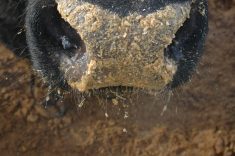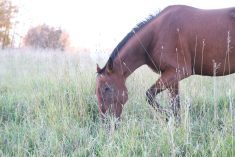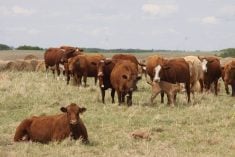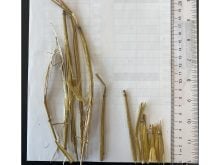Dexter Packet is pleased with the vertical feed mixer he bought last fall to replace his worn-out mix wagon and tub grinder.
“We’ve had a couple of years of drought here and good quality feed is in short supply, so we use it for mixing off some poor quality hay with good hay,” said the commercial cow-calf producer from Lafleche, Sask.
Vertical feed mixers are becoming the tool of choice for producers to combat the rising cost of feed while safeguarding feed quality in dry years.
Read Also

Trump’s tariffs take their toll on U.S. producers
U.S. farmers say Trump’s tariffs have been devastating for growers in that country.
“I’ve seen a trend the last 10 years of beef producers moving towards vertical feed mixers. That trend has really accelerated the last five years,” said Lee Norheim of Norheim Ranching, a livestock equipment dealership in Saskatoon.
“By using a vertical feed mixer, you can more accurately create your rations. You can start feeding cows by the pound instead of by the bale. When feed is expensive, you want to stretch it as far as you can.”
Norheim said many cattle producers have switched to silage to get more out of annual crops such as barley and corn.
The 2021 drought motivated many producers to use alternative feed sources such as kochia, other weeds, screenings and old potatoes. Those required mixing methods they had not previously considered.
Cows can eat a range of foods but can be picky if given free choice.
“If you threw 10 lb. of kochia in front of her, she probably wouldn’t eat it. But if you take 10 lb. of kochia and mix it with some straw and good alfalfa hay, or a little bit of silage or maybe some barley pellets, now she’ll eat it,” said Norheim.
“You can mix up a whole bunch of marginal commodities with a few good commodities and make a ration.”
Producers understand the cost of feed, “so it’s not just a tool for drought. Even in good years, when there’s lots of rain and the crops are bountiful … you can grow all your feed on 200 acres instead of 600 acres, grow it on 200 acres and use the additional 400 acres for something else.
“Once guys have made the investment in a vertical feed mixer, even in a good year when they have lots of feed, they don’t stop using it because the feed has a real value.
“(The mixers) really allow guys to stretch their feed and use a wider range of commodities.”
















